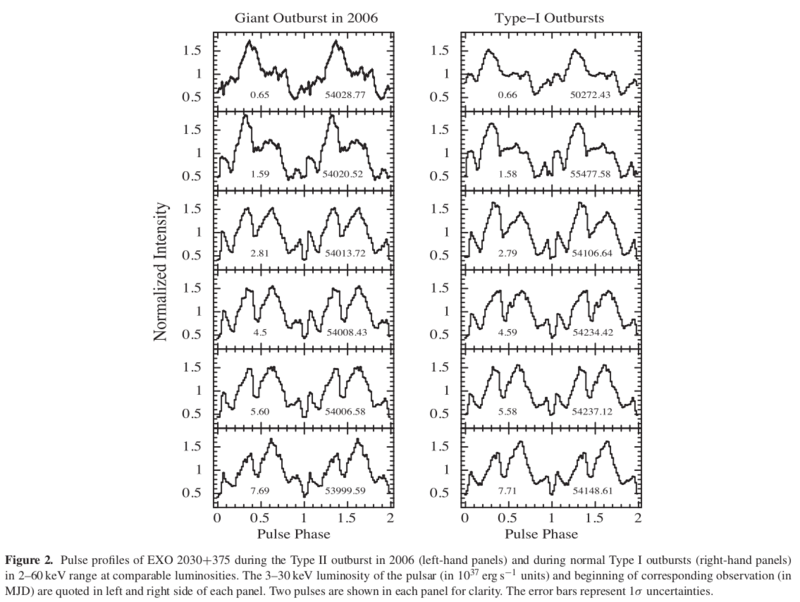EXO 2030+375
Jump to navigation
Jump to search
Other Names
- V2246 Cyg (SIMBAD)
Monitoring Data:
Fermi/GBM Swift/BAT MAXI BeXRB-Monitor
General Characteristics
- Discovered 1985 by EXOSAT ([1])
- Optical companion: B0 Ve ([2])
- Distance: [math]\displaystyle{ 7.1,\text{kpc} }[/math] ([3])
- Very reliable Type I outburst at around ~100 mCrab over 10-20 days ([3])
- Three giant outburst to far stretching several months each: 1986, 2006 & 2021
- Kozai-Lidov oscillations in the Be-disk as possible driver of giant outbursts [4])
- ~0.2 Hz QPO ([5]) with luminosity dependent frequency ([6])
Orbital Parameters
- Orbital period: [math]\displaystyle{ P_{\text{Orb}} = 46.0211(3)\,\text{d} }[/math] ([7])
- Epoch of periastron passage: [math]\displaystyle{ T_0 = 52802.20(1)\,\text d }[/math] ([7])
- Projected semimajor axis:[math]\displaystyle{ a_{\text x}\sin i = 248(12)\,\text{lt-s} }[/math] ([7])
- Eccentricity:[math]\displaystyle{ e = 0. 0.409(1) }[/math] ([7])
- Longitude of periastron: [math]\displaystyle{ \omega = 212.0(4)^{\circ} }[/math] ([7])
Pulsations
- Pulse profiles strongly luminosity dependent: ([8],[9])
- Two main peaks, one dominant at high and one at low luminosities
- Interpreted as switch from pencil- to fan-beam pattern
- One prominent and stable dip in pulse profile
- Another very sharp dip one at specific luminosity
- Pulse profile evolution similar between outbursts
Figure taken from [10]
Spectral Analysis
- Partially covered cutoffpl + black-body + neutral and ionized Iron lines
- Also fitted with BW07 ([11])
- Spectrum becomes harder with luminosity at lower luminosity and softer at higher luminosity ([6])
- Strong spectral changes with orbital phase:
Possible Cyclotron Features
- During Type I outburst ~36 keV ([12])
- During 2006 giant outburst ~11 keV ([7])
- During 2006 giant outburst ~63 keV ([13])
None of those is conclusively detected ([11])
References
- ↑ Parmar, A. N., White, N. E., & Stella, L. 1989a, ApJ, 338, 373, (NASA ADS)
- ↑ Reig, P., & Coe, M. J. 1998, MNRAS, 294, 118, (NASA ADS)
- ↑ 3.0 3.1 Wilson, C. A., Finger, M. H., Coe, M. J., Laycock, S., & Fabregat, J. 2002, ApJ, 570, 287, (NASA ADS)
- ↑ Laplace, E., Mihara, T., Moritani, Y., et al. 2017, A&A, 597, A124, (NASA ADS)
- ↑ Angelini, L., Stella, L., & Parmar, A. N. 1989, ApJ, 346, 906, (NASA ADS)
- ↑ 6.0 6.1 Reig, P., & Nespoli, E. 2013, A&A, 551, A1, (NASA ADS)
- ↑ 7.0 7.1 7.2 7.3 7.4 7.5 Wilson, C. A., Finger, M. H., & Camero-Arranz, A. 2008, ApJ, 678, 1263, (NASA ADS)
- ↑ 8.0 8.1 Ferrigno, C., Pjanka, P., Bozzo, E., et al. 2016, A&A, 593, A105, (NASA ADS)
- ↑ 9.0 9.1 Fürst, F., Kretschmar, P., Kajava, J. J. E., et al. 2017, A&A, 606, A89, (NASA ADS)
- ↑ McBride, V.A., Wilms, J., Coe, M.J., et al., 2007, A&A 470, 1065 (NASA ADS)
- ↑ 11.0 11.1 Epili, P., Naik, S., Jaisawal, G. K., & Gupta, S. 2017, MNRAS, 472, 3455, (NASA ADS)
- ↑ Reig, P., & Coe, M. J. 1999, MNRAS, 302, 700, (NASA ADS)
- ↑ Klochkov, D., Santangelo, A., Staubert, R., & Ferrigno, C. 2008, Astronomy and Astrophysics, 491, 833, ([ https://ui.adsabs.harvard.edu/abs/2008A&A...491..833K/abstract NASA ADS])
